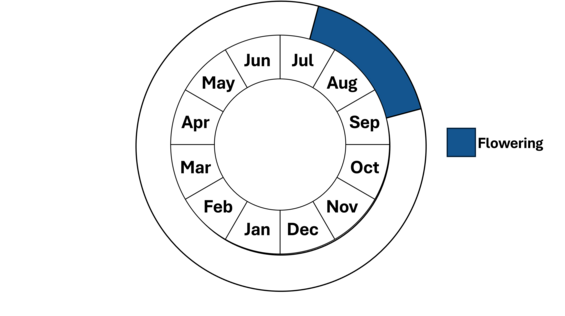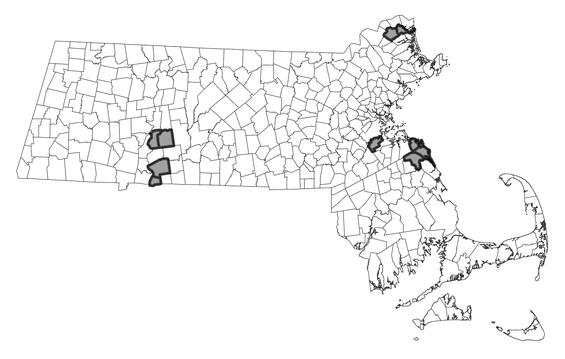- Scientific name: Rumex verticillatus L.
- Species of Greatest Conservation Need (MA State Wildlife Action Plan)
- Threatened (MA Endangered Species Act)
Description
Swamp dock, Rumex verticillatus, is a tall, herbaceous perennial of swamps and wet lowland woods, with numerous, inconspicuous, drooping, green flowers. Swamp dock, also known as water-dock, is a member of the buckwheat family (Polygonaceae) that grows up to 1.5 m tall (about 5 ft). The plant is smooth throughout with many short axillary branches and a taproot. The flat, lance-shaped leaves are alternate on the stem, and the leaf margins are entire. Lower leaves are up to 30 cm (about 1 ft) long. Like all members of the family, plants have thin membranous sheaths (ocrea) marked with longitudinal lines (striae) surrounding the stem just above the base of the leaf. Swamp dock blooms between July and September, and the small, greenish flowers are grouped in pendulous whorls. Flowering stalks (pedicels) are 10-15 mm (about 0.5 in) long, club-shaped, and sharply divergent from a jointed base. Flowers have 6 sepals: the inner three (valves) are broadly triangular-ovate, 4-5 mm (0.2 in) long, truncate at the base, and very thick toward the center, while the outer three (grains) are about 3 mm (0.1) long, lanceolate and with a blunt base that extends 0.5 mm below the valves. The fruit is a small (about 3 mm long; 0.1 in), shiny, brown trigonous achene.
Rumex triangulivalvis (triangular-valved swamp dock) is most similar, but has very short, jointed pedicels up to two times the fruit length but not two to five times, as in R. verticillatus. R. crispus (curly dock) has leaves with curly margins and shorter flowering stalks (5-10 mm; 0.2-0.4 in) that are jointed in the middle.
Life cycle and behavior
This is a perennial species.

Population status
Swamp dock is listed as threatened in Massachusetts. As with all species listed in Massachusetts, individuals of the species are protected from take (picking, collecting, killing, etc) and sale under the Massachusetts Endangered Species Act. There are eight populations that have been documented since 1999 in Essex, Hampden, Hampshire, Norfolk, and Plymouth Counties. Three populations have not been relocated recently.
Distribution and abundance
Swamp dock occurs from Quebec and Ontario in Canada south to Minnesota, Nebraska and New Mexico and Florida. In New England, swamp dock is not known to occur in Maine or New Hampshire, and has not been evaluated in Connecticut, Rhode Island or Vermont. It is critically imperiled in Massachusetts.

Distribution in Massachusetts
1999-2024
Based on records in the Natural Heritage Database
Habitat
Swamp dock is found in water or in places that are periodically flooded, such as stream and river floodplains, swamps, marshy shores, and drainage or irrigation ditches, and possibly brackish situations. The similar triangular-valved swamp dock (R. triangulivalvis) may be found in similar habitats. In Massachusetts, swamp dock has been found growing with spatterdock (Nuphar sp.), water-plantains (Alisma spp.), arrowheads (Sagittaria spp.), common and bulblet water-hemlock (Cicuta maculata and C. bulbifera), and buttonbush (Cephalanthus occidentalis). Associated tree species are silver maple (Acer saccharinum), red maple (Acer rubrum), green ash (Fraxinus pennsylvanica), and cottonwood (Populus deltoides).
Healthy habitats are vital for supporting native wildlife and plants. Explore habitats and learn about conservation and restoration in Massachusetts.
Threats
Alteration to the natural hydrology of its habitat is a primary threat.
Conservation
As for many rare species, the exact needs for the management of swamp dock are not known. The following comments are based primarily on observations of populations in Massachusetts. The occurrence of swamp dock is linked to the availability of suitable floodplain habitat that remains wet well into spring and summer, such as low-lying wet depressions within floodplain forests and borders of permanently wet buttonbush swales. Any alteration of water levels should be avoided. Floodplain habitats required for swamp dock are rare in the state due to housing and industrial development, restrictions on flooding regimes by river control projects, and conversion of these highly fertile areas to agricultural lands. The success of swamp dock in Massachusetts will depend on protecting suitable remaining floodplain areas. Although existing anthropogenic ditches or irrigation canals may also provide habitat for this species, such features alter wetlands and should not be considered as viable alternative habitats.
Contact
| Date published: | May 8, 2025 |
|---|